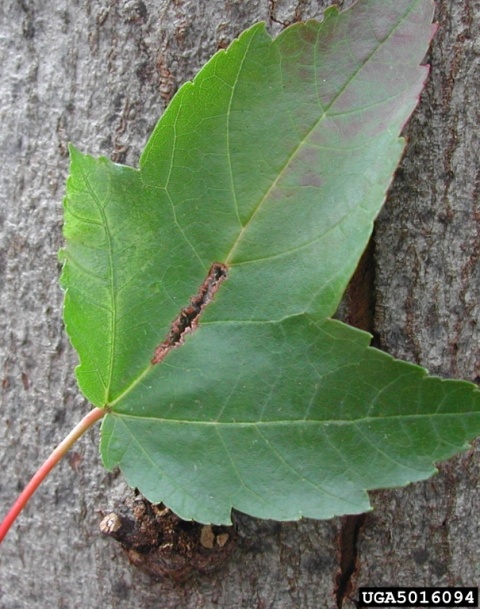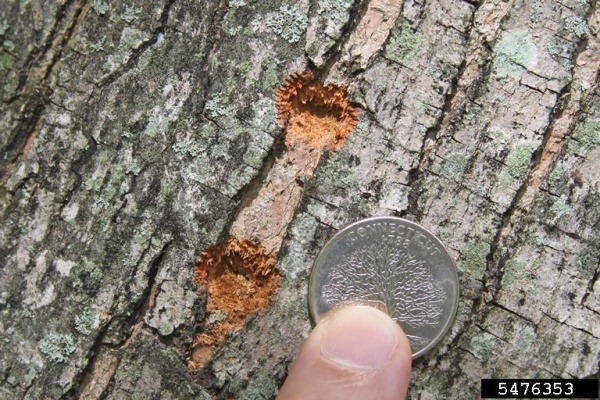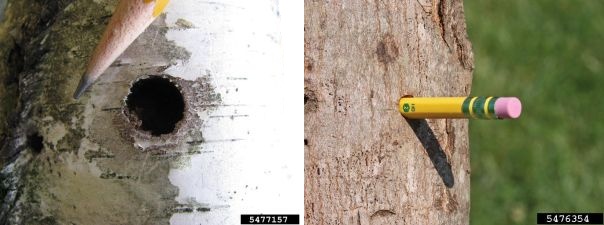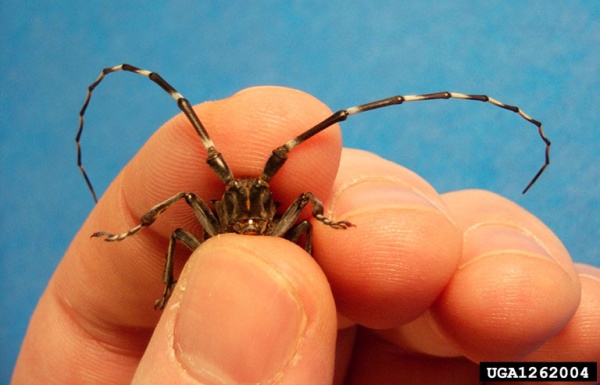
Eeeeewww! It’s an alien!
I’m not kidding. This bug is an alien invader from China that hitchhikes as larvae in wooden packing material. When it gets here it eats trees … lots of them! If it shows up in your neighborhood it has to be eradicated. Otherwise your town is doomed.
The Asian longhorned beetle (Anoplophora glabripennis (Motschulsky, 1853)), or ALB, is a very large wood-eating beetle native to China and the Korean peninsula. Its white-spotted black body is an inch long with antennae 1.5 to 2 times longer than its body. The antennae are unique, banded black and white.
Because it arrives in infected wood, ALB’s first location in North America is a warehouse. From there it spreads unpredictably, depending on the shipment. It’s been found in suburbs and cities in New York, New Jersey, Massachusetts, Illinois, Ohio and Ontario. Click here for the map as of July 2015.
When the beetle gets loose it’s not picky. Its eats maples, elms, birches, willows, poplars, ashes, hackberries, horsechestnuts, London planetrees … just about anything … but it takes 3-4 years to notice it. The adults are active late spring until fall so July is a good time of year to see its damage or the bug itself.
And this bug is noticeable. Big and showy, even its larvae (at left) are huge.

If you don’t see the bug you may see its evidence.
This unusual leaf damage is a hallmark of ALB. They eat the ribs of leaves, not the papery part.

Its entrance and exit holes are unique, too.
The female excavates a niche in the bark and lays her eggs in the hole. Each roughly chewed egg niche is half the size of a dime.

To get out of the tree, the beetle chews a perfect-circle hole as big as a pencil!

We can stop ALB if he’s confined to cities but if he gets loose in our forests all bets are off.
So if you see an Asian longhorned beetle or its damage, report it. There are some look alikes, but USDA wants us to be better safe than sorry. Call them at 1-866-702-9938 or click here for details.
Report this invader! Don’t let him take hold!

Read more about Asian longhorned beetles at USDA’s beetlebusters.info website.
(beetle animation linked from USDA’s website, photos from Bugwood.org)
The map link wasn’t allowed to load as a secure site. Might be a problem with it, so I thought I’d let you know. Thanks for the very valuable information.
Norca, I fixed the map link. It should work now.
Thanks for fixing the link, Kate. Looks pretty established in the northeast.
Is there a map for the entire U.S. somewhere? I’d like to see the whole picture (I think :().
Norca, I believe that map is the total extent of the bug as of July 2015. Here’s the USDA’s list of quarantines: https://www.aphis.usda.gov/aphis/resources/pests-diseases/asian-longhorned-beetle/Quarantines